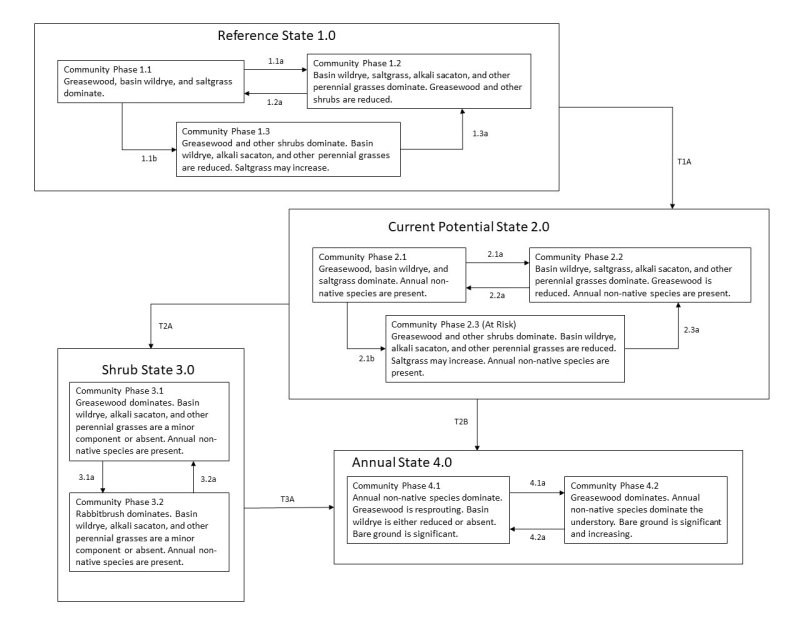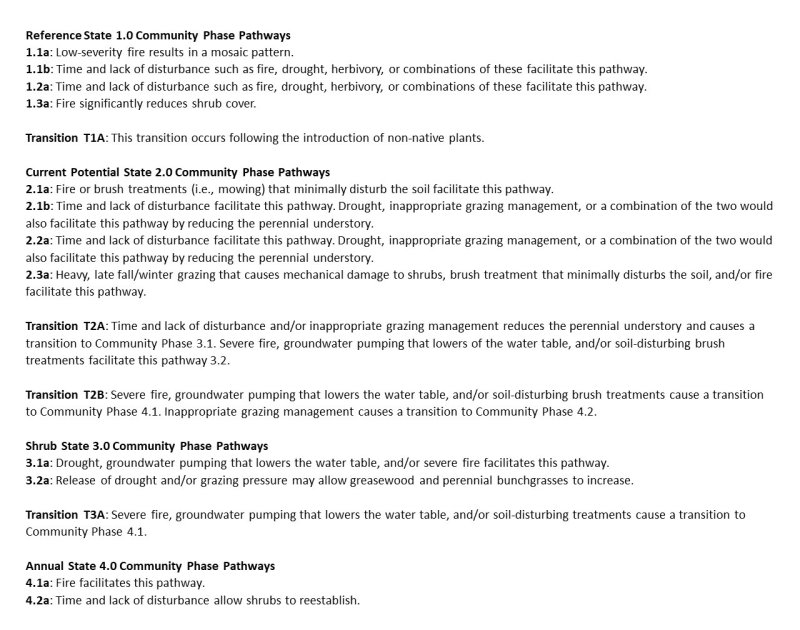Ecological site group R023XY924CA
Lake Basins and Terraces with Greasewood and Saltgrass
Last updated: 06/03/2024
Accessed: 12/21/2025
Ecological site group description
Key Characteristics
- Site subject to Ponding or Flooding
- Site has sodic soils properties
Provisional. A provisional ecological site description has undergone quality control and quality assurance review. It contains a working state and transition model and enough information to identify the ecological site.
Physiography
This group is on basin floors and lake terraces at elevations between 4,000 and 5,500 feet. Slopes are 0 to 5 percent. Sites receive supplemental moisture as in flow or subsurface water.
Climate
The climate is classified as Cold Semi-Arid in the Koppen Classification System.
The area receives 8 to 12 inches of annual precipitation as snow in the winter and rain in the spring and fall. Summers are generally dry.
The frost-free period is 80 to 115 days.
Soil features
The soils in this group are deep. Soil textures are clayey to loamy. Parent materials include alluvium and lacustrine deposits. Soil temperature regimes are mesic. Taxonomically, theese soils are principally Aridisols or Inceptisols. The common soil series in this group are Bobert, Yobe, and Honlak.
Vegetation dynamics
Ecological Dynamics and Disturbance Response:
An ecological site is the product of all the environmental factors responsible for its development. Each site has a set of key characteristics that influence its resilience to disturbance and resistance to invasives. According to Caudle et al. (2013), key characteristics include:
1. Climate factors such as precipitation and temperature.
2. Topographic characteristics such as aspect, slope, elevation, and landform.
3. Hydrologic processes such as infiltration and runoff.
4. Soil characteristics such as depth, texture, structure, and organic matter.
5. Plant communities and their associated functional groups and productivity.
6. Natural disturbance (fire, herbivory, etc.) regime.
Biotic factors that influence resilience include site productivity, species composition and structure, and population regulation and regeneration (Chambers et al., 2013).
The ecological sites in this group are dominated by greasewood (Sarcobatus vermiculatus) with an understory of saltgrass (Distichlis spicata). Alkali sacaton (Sporobolus airoides) and basin wildrye (Leymus cinereus) are also common on these sites. Greasewood is a phreatophyte (Eddleman, 2002), and its distribution is well correlated with the distribution of groundwater (Mozingo, 1987). Meinzer (1927) discovered that the taproots of greasewood could penetrate 20 to 57 feet below the surface. Romo (1984) found water tables at 3.5 to 15 meters under greasewood-dominated communities in Oregon. Greasewood stands develop best where moisture is readily available, either from surface or subsurface runoff (Brown, 1965). It is common on floodplains that are either subject to periodic flooding, have a high water table at least part of the year, or have a water table less than 34 feet deep (Harr & Price, 1972; Blauer et al., 1976; Branson et al., 1976; Blaisdell & Holmgren, 1984; Eddleman, 2002). Greasewood is usually a deep-rooted shrub but has some shallow roots near the soil surface; the maximum rooting depth can be determined by the depth to a saturated zone (Harr & Price, 1972).
Ganskopp (1986) reported that water tables within 9.8 to 11.8 inches of the surface had no effect on greasewood in Oregon. However, a study conducted in California found that greasewood did not survive 6 months of continuous flooding (Groeneveld & Crowley, 1988; Groeneveld, 1990). Additionally, seasonally high water tables are necessary for maintenance of productivity and reestablishment of basin wildrye following disturbances such as fire, drought, or excessive herbivory (Eckert et al., 1973). The sensitivity of basin wildrye seedling establishment to reduced soil water availability increases as soil pH increases (Stuart et al.,1971). When extended drought or water pumping lowers the water table, basin wildrye production and establishment decreases while greasewood, rabbitbrush, saltgrass, and invasive weeds increase.
Drought initially causes a decline in bunchgrasses; prolonged drought eventually causes a decline in shrubs, including black greasewood. Marcum and Kopec (1997) found saltgrass was more tolerant of increased levels of salinity than alkali sacaton. Therefore, dewatering and/or long-term drought that cause increased levels of salinity would create environmental conditions more favorable to saltgrass over alkali sacaton. Alkali sacaton is a facultative wet species in this region. Therefore, it is not drought tolerant. Groundwater pumping that lowers the water table may contribute to the loss of deep-rooted species such as greasewood and basin wildrye and an increase in rubber rabbitbrush (Ericameria nauseosa), shadscale saltbush (Atriplex confertifolia), and other species that are not groundwater dependent. Annual non-native species such as saltlover (Halogeton glomeratus) and cheatgrass (Bromus tectorum) invade sites where competition from perennial species is decreased.
Five possible stable states have been identified for this group.
Fire Ecology:
Fire is a rare disturbance in these plant communities. It likely occurs in years with above average production. Estimated natural fire return intervals vary from less than 35 years to up to 100 years in salt desert ecosystems with basin wildrye (Paysen et al., 2000). Historically, greasewood-saltbush communities were somewhat resistant to fire because they had sparse understories and bare soil in intershrub spaces (R. Young, 1983; Paysen et al., 2000). They may burn only during high fire hazard conditions; for example, years with high precipitation can increase the continuity of fine fuels which increases fire hazard (West, 1994; Paysen et al., 2000).
Greasewood may be killed by severe fires but can resprout after low- to moderate-severity fires (Robertson, 1983; West, 1994). Sheeter (1968) reported that following a Nevada wildfire, greasewood sprouts reached approximately 2.5 feet within 3 years. Grazing and other disturbances that increase biomass production via sprouting and seed production also lead to greater fuel loads (Sanderson & Stutz, 1994). Sites with higher production would experience fire more frequently than sites with lower production.
Saltgrass cover may decrease after fire, but stem density may also increase. It is top-killed by fire but resprouts from rhizomes. The saltgrass seedbank survived fire in some studies (Hauser, 2006). Seeds may also be dispersed into the burned site by water.
Livestock/Wildlife Grazing Interpretations:
Greasewood is typically not an important browse species for wildlife and livestock. However, in a study by Smith et al. (1992), utilization of new growth on greasewood shrubs by cattle was 77 percent in summer, and greasewood was found to have the highest amounts of crude protein when compared to perennial and annual grasses. Greasewood plants can contain high amounts of sodium and potassium oxalates which are toxic to livestock. Caution should be taken when grazing these communities. These shrubs can be used lightly in the spring if there is a substantial amount of other preferable forage available (Benson et al., 2011). Greasewood also provides good cover for wildlife species (Benson et al., 2011). During settlement, many of the cattle in the Great Basin wintered on extensive basin wildrye stands; many of these stands were decimated by the early 20th century, however, due to basin wildrye’s sensitivity to spring use (J. Young et al., 1976). Less palatable species such as greasewood, rabbitbrush, and saltgrass and invasive, non-native species such as povertyweed, Russian thistle (Salsola kali), mustards, and cheatgrass increased in dominance (Roundy, 1985).
Spring defoliation of basin wildrye and/or consistent, heavy grazing during the growing season can significantly reduce basin wildrye production and density (Krall et al., 1971). Basin wildrye is valuable forage for livestock (Ganskopp et al., 2007) and wildlife, but is intolerant of heavy, repeated, or spring grazing (Krall et al., 1971). Basin wildrye is used often as a winter feed for livestock and wildlife; it provides roughage above the snow and also cover in the early spring months (Majerus, 1992).
The ecological sites in this group have low to moderate resilience to disturbance and resistance to invasion. Resilience increases with elevation, northerly aspect, precipitation, and nutrient availability.
References:
Benson, B., D. Tilley, D. Ogle, L. St. John, S. Green, J. Briggs. 2011. Plant Guide: Black Greasewood. In: Plants database. U. S. Department of Agriculture, Natural Resources Conservation Service, Boise, ID.
Blauer, A.C., A.P. Plummer, E.D. McArthur, R. Stevens, and B.C. Guinta. 1976. Characteristics and hybridization of important Intermountain shrubs. II. Chenopod family. Res. Pap. INT-177. Ogden, UT: U.S. Department of Agriculture, Forest Service, Intermountain Forest and Range Experiment Station. 49 p.
Brown, R.W., Jr. 1965. The distribution of plant communities in the badlands of southeastern Montana. Bozeman, MT: Montana State University. 145 p. Thesis.
Eddleman, L.E. 2002. Sarcobatus vermiculatus (Hook.) Torr.: Black greasewood. In: Bonner, F.T. (tech. coord.). Woody plant seed manual, [Online]. Washington, DC: U.S. Department of Agriculture, Forest Service (Producer).
Groeneveld, D.P. 1990. Shrub rooting and water acquisition on threatened shallow groundwater habitats in the Owens Valley, California. In E. D. McArthur, E. M. Romney, S. D. Smith, and P. T. Tueller (compilers), Proceedings-Symposium on cheatgrass invasion, shrub die-off, and other aspects of shrub biology and management; 1989 April 5-7; Las Vegas, NV. Gen. Tech. Rep. INT-GTR-276. Ogden, UT: US Department of Agriculture, Forest Service, Intermountain Research Station. 351 p.
Hauser, S. A. 2006. Distichlis spicata. In: Fire Effects Information System, [Online]. U. S. Department of Agriculture, Forest Service, Rocky Mountain Research Station, Fire Sciences Laboratory (Producer). Available: https://www.fs.usda.gov/database/feis/plants/graminoid/disspi/all.html [2023, June 20].
Majerus, M. E. 1992. High-stature grasses for winter grazing. Journal of soil and water conservation 47:224-225.
Marcum, K.B. and D.H. Kopec. 1997. Salinity tolerance of turfgrasses and alternative species in the subfamily Chloridoideae (Poaceae). International Turfgrass Society Research Journal 8:735-742.
Meinzer, C.E. 1927. Plants as indicators of ground water. USGS Water Supply Paper 577.
Mozingo, H.N. 1987. Shrubs of the Great Basin: A natural history. Reno, NV: University of Nevada Press. 342 p.
Paysen, T. E., Ansley, R. J., Brown, J. K., Gottfriend, G. J., Haase, S. M., Harrington, M. G., Narog, M. G., Sackett., S. S., and R. C. Wilson. 2000. Fire in western shrubland, woodland, and grassland ecosystems. In Brown, J. K. and J. K. Smith (Eds.), Wildland fire in ecosystems: efects of fire on flora. Gen. Tech. Rep. RMRS-GTR-42-volume-2. Ogden, UT: US Department of Agriculture, Forest Service, Rocky Mountain Research Stations: Pgs 121-159.
Robertson, J.H. 1983. Greasewood (Sarcobatus vermiculatus (Hook.) Torr.). Phytologia. 54(5):309-324.
Romo, J. T. 1984. Water relations in Artemisia tridentata subsp. wyomingensis, Sarcobatus vermiculatus, and Kochia prostrata. Oregon State University, Corvallis, OR.
Sanderson, S.C. and H.C. Stutz. 1994. Woody chenopods useful for rangeland reclamation in western North America. In: Monsen, S.B. and S.G. Kitchen (compilers). Proceedings--ecology and management of annual rangelands; 1992 May 18-22; Boise, ID. Gen. Tech. Rep. INT-GTR-313. Ogden, UT: U.S. Department of Agriculture, Forest Service, Intermountain Research Station: Pgs 374-378.
Sheeter, G.R. 1968. Secondary succession and range improvements after wildfire in northeastern Nevada. Reno, NV: University of Nevada. 203 p. Thesis.
Young, J.A., R.A. Evans, and P.T. Tueller. 1976. Great Basin plant communities – pristine and grazed. In: R. Elston (ed.) Holocene climate in the Great Basin, Occasional Papers, Nevada Archeological Survey, Reno NV. Pgs 187-212.
Young, R.P. 1983. Fire as a vegetation management tool in rangelands of the Intermountain region. In: Monsen, S.B. and N. Shaw (compilers). Managing Intermountain rangelands--improvement of range and wildlife habitats: Proceedings of symposia; 1981 September 15-17; Twin Falls, ID; 1982 June 22-24; Elko, NV. Gen. Tech. Rep. INT-157. Ogden, UT: U.S. Department of Agriculture, Forest Service, Intermountain Forest and Range Experiment Station: Pgs 18-31.
Major Land Resource Area
MLRA 023X
Malheur High Plateau
Subclasses
Correlated Map Unit Components
21660502, 21659150, 21659713, 21659448, 21659758, 21659759, 21659864, 21659562, 21659427, 21660094, 21659867, 21659904, 21660604, 21660371, 21660374, 21660504, 21660343, 21660344, 21660536, 21500416, 21500423, 21500525, 21500439, 21501411, 21589790
Stage
Provisional
Contributors
DMP
T Stringham (UNR under contract with BLM)
Click on box and path labels to scroll to the respective text.

